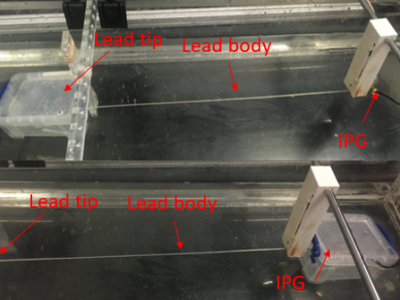1473
MRI RF Safety of Active Implantable Medical Devices (AIMDs): Experimental Study of the Effect of Conductivity of Tissue Simulating Media1University of Houston, Houston, TX, United States, 2Micro Systems Engineering Inc., Lake Oswego, OR, United States, 3Food and Drug Administration, Silver Spring, MD, United States
Synopsis
Experimental study of the effect of conductivity of tissue simulating media is performed for MRI RF safety of active implantable medical devices. The influence of medium surrounding the implantable lead tip, and the influence of medium surrounding implantable pulse generator are analyzed.
Purpose
The Tier 3 procedure defined in [1, 2] for testing electrically long active implantable medical devices (AIMDs) for MRI RF safety involves the development of transfer function models (TFM) of the AIMDs. The development of TFM is performed in standard tissue simulating medium (TSM) provided in [1]. There is concern that the standard homogeneous TSM may not well simulate the human environment for MRI RF safety since the influence of medium surrounding different portions of AIMDs have different contributions. This work addresses the different influences of medium surrounding implantable pulse generator (IPG) and medium surrounding lead tip to MRI RF-induced voltage TFM.Methods
Experimental methods were utilized. A 45 cm long commercial implantable lead with a commercial pacemaker IPG was used in experiments. Two sets of experiments were performed for IPG and lead tip in different media and the corresponding 64MHz TFMs were establish using the method proposed in [3, 4]. The setups of the two sets of experiments are shown in Figure 1.
In the first set of experiments, the IPG was submerged in saline (εr=78) with conductivity of 0.1 S/m, 0.47 S/m and 1.2 S/m respectively. The lead body and lead tip was submerged in saline with conductivity s=0.47 S/m.
In the second set of experiments, the lead tip was submerged in saline with conductivity of 0.1 S/m, 0.47 S/m and 1.2 S/m respectively. The lead body and IPG was submerged in saline with conductivity s=0.47 S/m.
Results
Magnitude and phase of the MRI RF-induced voltage TFM obtained from the first set of experiments are shown in Figure 2. And Magnitude and phase of the MRI RF-induced voltage TFM obtained from the second set of experiments are shown in Figure 3.Discussion
The TFM magnitudes and phases obtained for IPG and lead tip in different media show different variation. For the IPG submerged in saline with different conductivities, the TFM has almost no variation. Therefore, MRI RF-induced voltage TFM is not sensitive to the conductivity of IPG surrounding medium.
For the lead tip submerged in saline with different conductivities, the TFM varies in both magnitude and phase. This is because different tip surrounding medium results in different tip reflection, and therefore results in different TFM. And the MRI RF-induced voltage TFM is sensitive to the conductivity of lead tip surrounding medium.
The preliminary results suggest that the tissue parameter surrounding the lead tip should be considered as an important factor. Further investigations are required to analyze the details about different contributions of medium surrounding different portions of AIMDs, and to propose a systematic scheme to find the best tissue simulating medium.
Conclusion
For MRI RF-induced voltage TFM, the medium surrounding the lead tip has significant influence, whereas the medium surrounding the IPG has almost no influence. In developing the tissue simulating medium, the tissue parameter surrounding the lead tip should be considered as an important factor.Acknowledgements
No acknowledgement found.References
[1] ISO/TS 10974 Ed.1, Clause 10,
[2] ISO/TS 10974 Ed. 2, Clause 8,
[3] Feng S., Qiang R., Kainz W., and Chen J., “A Technique to Evaluate MRI-induced Electric Fields at the Ends of Practical Implanted Lead”, IEEE Trans. on Microwave Theory and Techniques, vol. 63, no. 1, Jan. 2015,
[4] J. Liu, J. Zheng, Q. Wang, W. Kainz, and J. Chen, “A Transmission Line Model for MRI-RF Field Induced on AIMD Evaluation,” Manuscript submitted for publication


